
On the 29th of May 2018, over 50 people died from lightning strike in a single day along the northern states of India. Further south, the state of Andhra Pradesh recorded 36,749 lightning strikes in just 13 hours. Lightning is the leading cause of death from natural disasters in India, taking an average of 1755 lives a year.
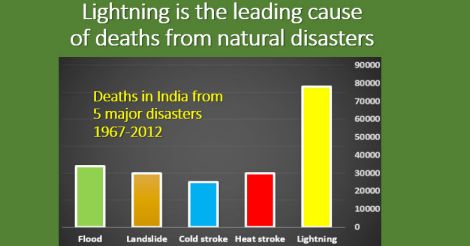
While natural disasters will continue to unleash their fury on earth, there are several ways to reduce our own risk of injury and death. In developed nations, the fatality rate from lightning has decreased, thanks largely to widespread awareness programs. For instance, in the US, only 16 people died of lightning in 2017, compared to 432 deaths in 1943.
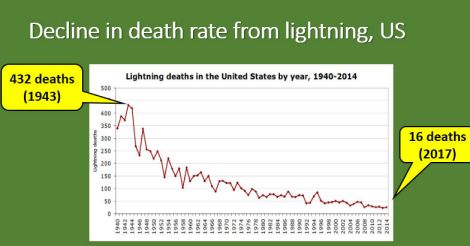
This article is written to explain the fascinating science behind lightning, debunk some popular myths and to discuss how we can stay safe.
How does lightning occur?
The formation of a thunderstorm involves rapid movement of air at low temperatures, the cloud particles becoming charged in the process. Negatively charged particles gravitate to the bottom half of the cloud. At the same time, opposing charge builds up on the ground far below. Because air is a poor conductor of electricity, initially nothing happens, and electrical charges continue to build up further. This can be likened to the gradual stretching of a rubber band.
Just as a rubber band that is slowly getting stretched will break abruptly in the end, the attraction between the opposing charges eventually overcomes the air resistance and the charges rush towards each other completing the electrical circuit. This massive spark of electricity is seen as lightning.
In addition to cloud-to-ground lightning, it is also common for lightning to travel between clouds—this is called cloud-to-cloud lightning. Occasionally, it can travel upwards from tall structures on the ground to the clouds.
What is thunder?
The sudden discharge of electricity in the form of a streak of lightning heats up the adjacent air to temperatures over 50,000 F, which is even hotter than the surface of the sun. As a result, a large number of superheated air molecules gets pushed sideways, colliding with other air molecules in the area. This generates a deafening noise, which we hear as thunderclap. The rumbling effect is created as sound waves get generated at multiple points along the length of the lightning streak.
How dangerous is lightning?
Surprisingly, although the amount of electricity discharged is massive, most people who get struck by lightning will survive. Some are left with nerve damage, others with scars on their body. As it can interfere with the electrical circuitry of the heart, a common reason for death by lightning strike is cardiac arrest. Prompt resuscitation can save such a person’s life.
Tips for surviving lightning.
1. Avoid being outdoors.
Lightning is nothing but a large spark of electricity that is trying to find the easiest and shortest path to the ground. Logically, it could hit the highest point, typically an isolated tall tree, telephone pole or a person who is standing up.
For example, if we are walking in an open field without trees during a thundershower, then we are the tallest structure, and could potentially become a target for lightning.
It is therefore unwise to be outdoors when there is lightning.
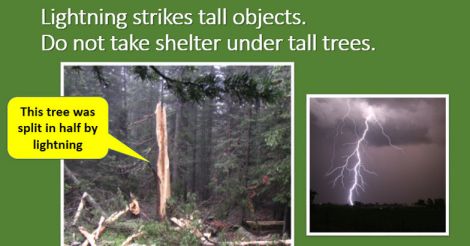
2. Do not take shelter under a tall tree.
It is unsafe to take shelter under an isolated tall tree, as it could attract lightning and pass it on to us. If caught in a forest, it is better to be either in a clearing or near the shortest trees—these are less likely to attract lightning.
3. Avoid being at high altitudes.
For the same reason, being at a hilltop or rooftop at such a time is considered risky. If caught in such a situation, we should quickly move to low-lying areas whenever possible.
Lightning travels along vertical surfaces to seek the ground, hence standing just below the overhanging edge of a cliff is also considered dangerous.
That being said, for a lightning bolt that is traveling to the ground at extreme speed from a height of several thousand feet, it is unlikely that small heights such as five or fifteen feet will make any difference on where exactly it hits the ground. Experts say that the bolt can hit anywhere on the ground, not necessarily at the tallest point.
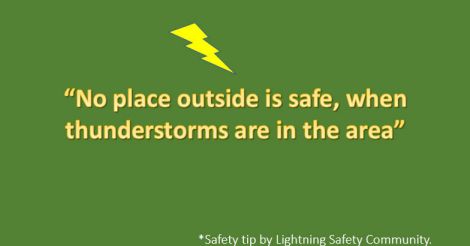
4. Know the types of lightning strikes.
Lightning can strike in various ways. While outdoors in an open area or on high ground, it can deliver a direct ‘vertical strike’ from above on to our body. Although this is the most lethal, it is uncommon.
More commonly, lightning spreads horizontally to our body after it hits the ground nearby. If we are within 200 m of the strike, then we are at risk. This type is also called ‘ground current’ or ‘step potential’ and accounts for about half of the fatalities.
A ‘side flash’ occurs when we are standing next to a tall object such as a tree and the electric current jumps across through the air to our body.
5. Do not lie down on the ground.
It is dangerous to lie down on the ground in an attempt to escape from lightning, as the electric charge from a nearby strike will spread horizontally along the ground.
6. Avoid fences and wires.
Lightning can also reach us through ‘conduction’, which is from contact with metallic objects such as a wire fence, plumbing or landline that is connected to the telephone pole. Staying away from such objects is therefore important.
7. Keep those feet together.
Ground current affects cattle and deer the most. This is because their feet are wide apart, creating a voltage gradient as lightning travels horizontally along the ground after a strike. The flow of current damages the heart as it enters through one leg and exits by the other, causing death.
When there is threat of ground current, keeping our feet close together will reduce injury. This is because the shorter the distance is between our feet, the smaller will be the voltage difference, and the less likely that our heart will be electrocuted.

8. What to do if a strike is imminent?
When the thundercloud is directly overhead, just before lightning strikes our body, we may experience a tingling on our skin, and our hair will stand up. The best thing to do if a strike is imminent and there is no way to get indoors, is to crouch down with only the tips of our feet touching the ground, while the heels are raised off the ground and touching each other.
By doing so we are making ourselves as small as possible, while minimising contact with the ground. This reduces the chance of both direct and ground lightning strike.
While crouching, if we can sit on a backpack or jacket, it serves as a potential electrical insulator. Once the overhead threat passes, we must run indoors to the safety of a building.
9. Avoid huddling together. Spread out.
If we are part of an outdoor group while the storm hits, instruct everyone to spread out at least 100 feet to minimise the risk of a mass casualty. This is because lightning can strike one person and then spread along the ground to hit people close by.
On the other hand, when people are spread out, even if one person gets struck, others will be able to come to the rescue.
It is worth noting in this context that lightning occurring as ground current instantly kills large numbers of animals that travel in herds. Two years ago in Norway, over 300 reindeer in a herd were killed during a single thunderstorm.
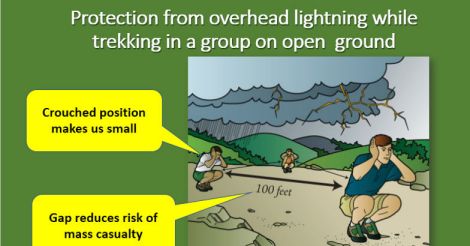
10. How to save a life.
If a person is found unconscious immediately following a lightning strike, CPR must be started without delay, and the victim must be shifted to hospital quickly. Doing CPR can save a life, because the heart would have stopped due to an electrical failure in its conducting system, and any time lost waiting for an ambulance can kill the person.
The method to do CPR in the field even without prior training was explained in my earlier article.
11. The metal myth.
Contrary to popular belief, there is no need to remove metallic objects from our body. Getting rid of items such as jewellery and watches does not protect us from lightning strike. At best, doing so might reduce the risk of skin burns in the unlikely event of our being hit. Considering the big picture, this advantage is therefore of questionable value.
12. Stay inside the car.
If we happen to be driving while the thunderstorm hits, the safest place to be is inside the vehicle with windows rolled up. That is because of the Farraday cage effect, where the metal shell of the car, a good conductor of electricity, takes the hit while the occupants are protected. It is important not to touch any of the metal parts of the vehicle till the storm passes. The best place for our hands is in our lap.
If lightning hits a moving car, it is usually not damaged. However, occasionally electrical failure is known to occur, which can include sudden and unexpected deployment of airbags. The car must therefore be parked safely, windows shut and ignition turned off while we wait out the storm.
Being inside a bus or a truck is also considered safe due to the protective metal frame. However, the protective effect does not extend to cyclists, bike riders, tractors or convertible cars due to the lack of a metal shell.
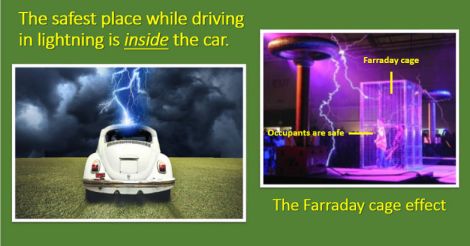
13. Planes are safe.
Those who fly regularly might wonder about the risk of the plane being hit by lightning while in the sky. Though strikes do occur, the hard shell of the aircraft essentially works like a flying Farraday cage, protecting its occupants as well as internal circuitry. No aviation accidents have occurred in the past 50 years from lightning strikes.
14. How far away was the strike?
At only 343 metres per second, sound travels much slower than light. This is why we get to see the lightning first, and then hear the thunder. The longer it takes for us to hear thunder after a flash of lightning, the farther away the strike is.
In fact, we can easily calculate how far away the lightning occurred simply by counting the number of seconds of delay between the flash and the sound.
If we divide the delay in seconds by 3, we can calculate the distance in kilometres. For example, if there is a 30 second delay after seeing the lightning flash to hear the sound of thunder, it means that the incident occurred 10 km away; that is 30 divided by 3.
When the delay is 15 seconds or less, it generally means that the next strike could be really close by.
Until a few years ago, the teaching was that if the delay was less than 30 seconds, it was time to get indoors to safety because lightning was within striking distance. However, that recommendation has now been replaced by the slogan: “When thunder roars, it is time to get indoors”. This means that one has to get to the safety of indoors as soon as the first clap of thunder is heard.
Besides, many experts now believe that it is futile to make such a calculation, because lightning can strike us even from 15 km away from the area of rainfall. This is due to its ability to travel long distances across the sky before descending to the ground.

15. The safest place is indoors.
Fortunately, most thunderstorms last 30 minutes or less, and the safest place to be at that time is deep inside a solid, fully enclosed building. It is wise to stay away from windows, avoid touching any metallic objects or wires and avoid leaning on concrete walls. Bus shelters, open sheds and tents are unsafe options.
16. Be careful immediately after the rain.
Studies have shown that up to half of lightning strikes occur immediately following the thunderstorm. Hence, it is important to wait a full 30 minutes indoors after the last clap of thunder, before venturing outdoors.
17. Bolt from the Blue.
Lightning can strike even when the weather is sunny. Aptly called ‘bolt from the blue’ this involves a positively charged lightning streak originating from a thundercloud, traveling long distances across the clear blue sky and finally striking ground that could be as far as 25 miles away.
18. No landlines please.
It is foolish to talk on a wired telephone (landline) during a thunderstorm, as they are directly connected to outdoor posts that might easily be struck by lightning. Mobile phones must be unplugged from their chargers. Using mobile phones is safe during lightning as they are not connected to telephone posts by a wire.
19. Unplug electrical devices.
If lightning strikes an electric post outside, the current can travel through the wires and hit us if we are using an appliance that is plugged in to the electrical outlet. Hence, it is unsafe to operate equipment such as the electric iron during thunderstorms.
At least a few people would be hopeful that surge protectors will prevent damage to electrical equipment during a lightning strike. Unfortunately, this is false. In fact, the huge blast of electricity from a lightning strike effortlessly jumps air-gaps and gets past fuses and circuit-breakers—almost as though they did not exist.
Therefore, unplugging is the only certain way to prevent damage to expensive equipment such as TV or computers during a thunderstorm.
20. The shower and the dishes can wait.
It is safer not to take a shower or wash hands or dishes under a tap during a thunderstorm. This is because running water is a good conductor of electricity; and we stand the risk of being electrocuted if there is a lightning strike nearby.
21. Get out of the water.
Lightning can hit boats or swimmers in the water, hence it is safer to come to the shore and stay indoors during a thunderstorm.
Although reported fatalities are exceedingly rare, swimming pools are considered unsafe during thunderstorms because they are connected to a larger area of the ground by wiring and plumbing. A lightning strike anywhere nearby can potentially spread to the pool. It is recommended not to use the pool till at least 30 minutes after the last clap of thunder.
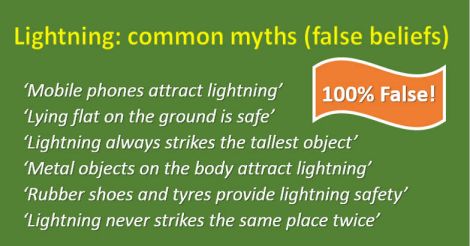
In summary, lightning strikes can be lethal or severely disabling. Almost having a mind of its own, it is impossible to predict exactly when and where a strike will occur. However, we do know that nearly all the fatalities have occurred outdoors—a case of being in the wrong place at the wrong time. It is better to avoid being outdoors if there is a thunderstorm warning.
The survival tips listed are only meant to reduce the risk of a strike if we are caught outdoors when a thunderstorm occurs unexpectedly. Being indoors is always the safest bet.
Photos: Sourced by the author
(The author is a senior consultant gastroenterologist and deputy medical director, Sunrise group of hospitals)

























